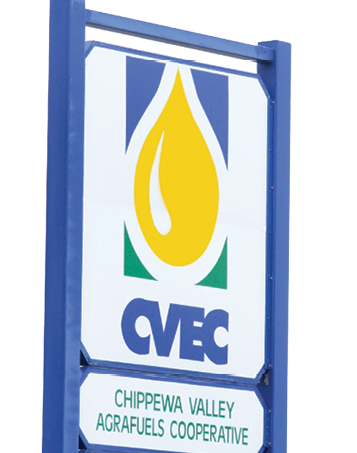–by Liz Morrison
 A Benson, Minn., ethanol maker hopes a customer loyalty program will encourage owners of flex fuel vehicles to choose the yellow pump.
A Benson, Minn., ethanol maker hopes a customer loyalty program will encourage owners of flex fuel vehicles to choose the yellow pump.
Chippewa Valley Ethanol Company (CVEC) is exploring ways to increase local sales of E85, the high-ethanol-blend fuel. The cooperative produces about 46 million gallons of ethanol a year. CVEC also blends E85 at the plant and distributes the fuel to about 30 gas stations in west central Minnesota.
AURI helped the company do a market study, asking flex fuel vehicle owners about their E85 buying habits and their interest in customer loyalty programs, such as reward cards.
“We wanted to get a better understanding of consumer motivation, and what it would take to sell more E85,” says Mike Jerke, general manager of the 900-member ethanol co-op. CVEC plans to use the proprietary information to create a new E85 customer loyalty program.
In the past, one-time E85 promotions have been well received by consumers, says Kelly Marczak, director of the American Lung Association’s Minnesota Clean Air Choice Program. Events such as E85 customer appreciation days or frequent fuel cards reward regular E85 buyers, and “provide an incentive for new customers to give E85 a try and continue using it to get that reward.”
A price-sensitive market
Fuel buyers are very sensitive to prices at the pump, Marczak says.
That was confirmed by the CVEC market study, which was performed by Minneapolis public relations firm Russell Herder. Consumers pay close attention to the price spread between regular unleaded gas and E85, Jerke says.
E85, which contains 70% to 85% ethanol, has less energy than regular gasoline, resulting in a mileage decrease of about 20%. When the price difference between E85 and gas is too narrow, many drivers of flex fuel vehicles stop pumping it, says Michael Sparby, senior project strategist at AURI.
In the last 12 months, for example, the monthly price spread in Minnesota has ranged from 8.8% to 23.61%, according to the website E85Prices.com. On Nov. 1, it averaged 19.8%, or $0.64/gallon.
The price difference between E85 and regular unleaded also varies sharply by location. In October, for example, price spreads reported by consumers on E85Prices.com ranged from 3% to 27%.
For a time last summer, E85 at many Minnesota gas stations was $1 or more per gallon cheaper than regular, which induced many consumers to choose the high-ethanol blend, Marczak says. E85 volume jumped to two million gallons in July and August, twice the monthly sales in the first quarter, the Minnesota Commerce
Department reports.
This shows that at the right price, Minnesotans who drive flex fuel vehicles will choose clean, renewable, locally produced E85, Jerke says. The marketing study found that “when consumers see a price spread that’s significant — 25% to 30% — they are motivated to use the product.”
Access to pumps a barrier
E85 use in Minnesota has varied sharply since 2006, while the number of E85 stations has remained flat.
But a significant barrier to E85 expansion is the lack of E85 pumps, says Tim Rudnicki, director of the Minnesota Biofuels Association, a trade association. Nationally, just over 2,350 gasoline stations dispense E85, according to the U.S. Department of Energy. That’s less than 3% of U.S. stations.
“Minnesota leads the nation in the number of E85 outlets and pumps,” with about 350 stations, Sparby says. But the number of Minnesota dispensers has been flat since 2009, especially in rural Minnesota, where average monthly E85 sales per station are less than half that of metro stations. However, “We are seeing renewed interest,” Marczak says, “and quite a few new retailers are adding E85 pumps in the second half of 2013.”
E85 can only be used in flex fuel vehicles, which are designed for high ethanol blends. Auto makers offered 62 flex fuel vehicle models in 2012, according to the U.S. Department of Energy. There are more than 14 million registered flex fuel vehicles on U.S. roads today — about 300,000 in Minnesota, the American Lung Association in Minnesota estimates.
This fleet has the capacity to consume at least 6.6 billion gallons of ethanol annually, according to a 2013 report from the Center for Agricultural and Rural Development at Iowa State University. Yet, despite the number of flex fuel vehicles on the road, “a lot of flex fuel vehicle owners don’t know they have the option of using E85,” Rudnicki says.
CVEC’s market study also found “a need for more education about E85,” Jerke says. For example, consumer interviews revealed that many drivers didn’t understand that flex fuel vehicles can switch back and forth between gasoline and E85. “They don’t need to use E85 every time they fill up.” That type of information could easily be conveyed with better marketing and pump displays, Jerke says.
“We think there are great opportunities.”
AURI and CVEC
Idea to reality:
Chippewa Valley Ethanol Company (CVEC) in Benson, Minn., an E85 blender, wanted to develop a customer loyalty program to spur sales of E85 at the west central Minnesota gas stations it supplies.
AURI’s role:
AURI helped the company manage a market study to evaluate consumer attitudes to E85 and their loyalty program preferences.
Outcome:
CVEC will use the market study to develop a customer rewards program to further develop the market for E85.

